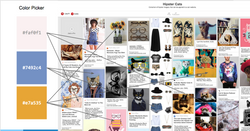Lisa Ratner


DESIGNING CURRICULUM
for Responsive Web Design
For Digital Media Academy (DMA) at Stanford, I designed a week long Responsive Web Design curriculum for highschoolers.
Curriculum Overview

Learner Journey
During a week of instruction a student will experience a range of emotions. Paying attention to how a class or even a project is structured to lead a student through this range is a fundamental step in the development process to ensure a student’s success. This design is intended to provide a balance of fun, challenging, difficult and relaxed moments at the right times to keep a student engaged and motivated.

Learner Persona
-
Incorporate a range of learning styles, e.g., visual-spatial, logical-mathematical, verbal-linguistic, interpersonal, kinesthetic.
Project Based Learning

-
This style contributes to greater creativity. The process of problem discovery, understanding, and solution-finding are all parts of the creativity process.
-
Project-based learning reinforces higher-order thinking skills, generates a higher level of student engagement, and builds student confidence and collaboration skills, all while focused on producing a creative outcome.
-
Create multiple versions of an activity so that students may choose to direct their own learning.
-
I set up opportunities for hands-on experimentation and collaborative work as part of your instructional unit.
-
Provide ample time for students to manipulate, discuss, and experience both setbacks and success.
-
Provide materials and equipment that will spark and encourage student experimentation and production.
Student Deliverables
 Ideation |  Competitive Audit |  Personas |
|---|---|---|
 User Journey |  Sketches |  Prototyping |
 Moodboards |  Moodboard |  Color Palatte |
 Finished Style Guide |  Web Production Tools |  Coding |
 Mobile Web Design |

Working with the d.School at Stanford University, DMA has refined the creative process that students will progress through when completing their projects.
This sequence of steps directs students in the creation process from understanding the problem to testing solutions. This is an iterative process in which a student will evaluate their solution, gather ideas on how to improve and revise their original solution.